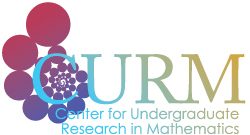What follows is meant to guide your thinking about what you might include in your proposal apart from the required elements already listed in the application instructions. We have not provided an exhaustive list that necessarily describes every person’s situation. Instead, we hope to prompt ideas from you that will help you convince us that your proposal should be funded. It may help to keep the high level CURM program goals in mind:
- Increased transfer rates from two-year and community colleges to four-year institutions
- Increased access to high impact research experiences for early career students
- Improved sense of mathematical belonging for early career students
In the personal statement, some items we look for are:
- How would a CURM mini-grant benefit your students? Every student will benefit from successfully doing undergraduate research. That is a given. However, some distinguishing aspects might be:
- You see a CURM mini-grant as a concrete way to create transfer pathways between institutions. Describe how and why a mini-grant would increase the likelihood of completing a four year degree for your students.
- Many of your students are first-generation college students and are unaware of career opportunities and other benefits of studying math and the CURM experience would help expose them to these ideas.
- The recruiting and retention of math students is difficult at your institution. Can you explain how a CURM mini-grant would help you with this?
- There are not many research opportunities in math for early career students. A CURM mini-grant would give students an initial experience in doing undergraduate research that would help excite them about math research while also giving them some substantial experience to help prepare them for either a summer REU or for majoring in math.
- Explain why the research area you have selected is one that is likely to be successful for your students and institution.
- How would a CURM mini-grant benefit you? Every professor who applies would benefit from the joy of doing more undergraduate research. However, some distinguishing aspects might be:
- You have never done undergraduate research with students before, and you are excited for the professional development opportunities provided through the CURM program.
- If you were awarded the mini-grant then your department chair would agree to let you teach a special seminar in the fall related to a research topic as one of your regular teaching courses;
- You will be on sabbatical during one of the semesters and you plan to use part of this time to work more than usual with your undergraduate research group.
- Your department chair or dean is very supportive of you doing undergraduate research and so in addition to what the mini-grant provides, they have offered you additional supports. Describe how these items will support your goals for the research group.
- You have previously applied for a grant related to promoting undergraduate research but were denied because the reviewers felt that you did not have enough experience. A CURM mini-grant would help you gain more experience and make a stronger proposal when you apply for that same grant next year.
- You have been increasingly isolated from an active mathematical community and are looking for ways to connect through research with students.
- Other considerations include evidence that you are someone who makes the most of your opportunities. What activities have you undertaken to improve the mathematical world around you?
In the collaboration statement, some items we look for are:
- If there is an existing relationship between you and your partner, what are the defining qualities of the relationship? What projects have you worked on together? How will you build on your preexisting connections to support your students?
- If this is a new collaboration, how do you foresee the collaboration unfolding? Why is this collaboration one that is beneficial to your students? How will you handle disagreements? How will you build shared values?
- How well are your institutions connected? If not well, how will this mini-grant help build connections? If well, how will you use this mini-grant to build on existing structures to support the funded activities?
- Finally, we would like to see your plans for engaging the research groups in collaboration during the academic year. These plans might include joint social activities, joint research meetings, campus visits or exchanges, or other interactions meant to build relationships between the groups.
In the recruitment plan, some items we look for:
- Efforts to reach out to students who might not put themselves forward for a research experience
- Outreach to students from groups that have been minoritized in mathematics
- Plans to attract early career students
To help you think about the which research area to select, here are some example projects that the CURM leadership have completed with early career students:
Data Science:
- Examining human rights issues through the lens of statistics (statistics)
- Using topic modeling to create personalized health protocols (linear algebra)
- Using recommender systems to help students choose GE courses (statistics, linear algebra)
- Using data visualization to examine flight data and determine best times to fly (statistics, geometry)
- Determining how fake news spreads on social media (statistics, graph theory)
Discrete Math:
- Identifying strategies for first or second players in combinatorial games
- Investigating processes on graphs such as pebbling, graceful labeling, coloring
- Characterizing combinatorial games
Math Modeling:
- Analyzing global climate change data collected by the World Wildlife Fund
- Using epidemiological models to study spread of extreme political views
- Modeling effect of climate change on distribution of disease-spreading mosquitoes
- Maximizing impact of building demolition to address shrinking city footprints and budgets
Math Education:
- Using institutional or other data to evaluate academic interventions and their effects on student retention.
- Who transfers and how do they transfer to 4-year universities?
- Assessing the impact of high-impact practices on student learning outcomes
